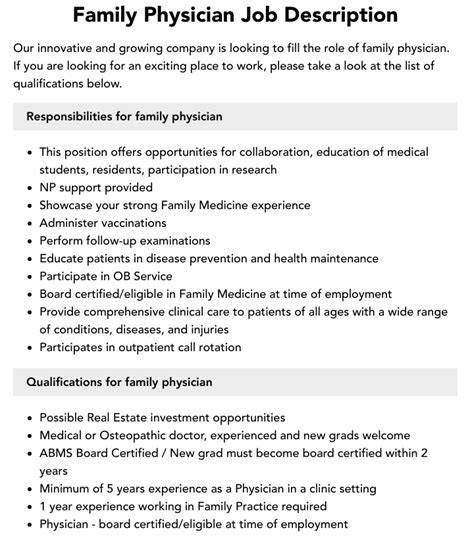Introduction

Family physicians play a crucial role in providing healthcare to families and individuals of all ages. With their extensive training and diverse skillset, they are responsible for a wide range of job duties that contribute to the well-being of their patients. This article provides a comprehensive overview of the job duties of family physicians, encompassing their day-to-day responsibilities, patient interactions, and collaborative efforts within the healthcare system.
Comprehensive Understanding of Patient Needs
Assessment and Diagnosis
- Conduct thorough physical examinations and medical histories to identify potential health issues.
- Utilize diagnostic tools and tests, such as bloodwork, imaging, and biopsies, to aid in diagnosis.
- Formulate accurate diagnoses based on patient symptoms, examination findings, and test results.
Treatment and Management
- Prescribe medications, recommend lifestyle modifications, and provide counseling to manage various health conditions.
- Perform minor surgical procedures, such as suturing wounds, removing cysts, and performing biopsies.
- Collaborate with specialists to provide comprehensive care for patients with complex medical conditions.
Preventive Care and Health Promotion
- Administer immunizations to prevent infectious diseases.
- Conduct screenings for early detection of chronic conditions, such as diabetes, hypertension, and cancer.
- Provide guidance on healthy lifestyle choices, including diet, exercise, and stress management.
Patient Education and Counseling
- Communicate clearly with patients, explaining diagnoses, treatment options, and preventive measures.
- Provide support and guidance to patients and their families regarding psychosocial issues, such as grief, anxiety, and substance abuse.
- Refer patients to mental health professionals or other support services as needed.
Collaborative Healthcare Relationships
Interdisciplinary Collaboration
- Consult with specialists in various medical fields, such as cardiology, neurology, and oncology, to provide comprehensive patient care.
- Participate in multidisciplinary teams, involving nurses, pharmacists, and social workers, to ensure coordinated care for patients.
- Refer patients to home health agencies, physical therapy, or occupational therapy to complement their treatment plans.
Community Involvement
- Participate in community health initiatives, such as health fairs, school screenings, and educational programs.
- Collaborate with local organizations and agencies to address public health concerns and improve access to care.
- Advocate for policies that promote health equity and improve the well-being of their community.
Administrative and Managerial Responsibilities
Patient Records Management
- Maintain accurate and detailed medical records, including patient histories, examination findings, and treatment plans.
- Utilize electronic health records (EHRs) to facilitate patient care and communication with other healthcare providers.
- Ensure timely and appropriate documentation for billing and insurance purposes.
Practice Management
- Manage their practice, including scheduling appointments, hiring staff, and ordering supplies.
- Implement quality improvement measures to enhance patient outcomes and practice efficiency.
- Negotiate with insurance companies and billing offices to ensure appropriate reimbursement.
Continuing Education and Professional Development
- Attend continuing medical education (CME) courses and conferences to stay current with advancements in medical knowledge and practice.
- Participate in research and clinical trials to contribute to the body of medical knowledge and improve patient care.
- Maintain board certification to demonstrate their ongoing commitment to providing high-quality medical care.
Statistics and Projections
According to the American Academy of Family Physicians (AAFP), there are approximately 200,000 practicing family physicians in the United States. The Bureau of Labor Statistics (BLS) projects a 9% growth in employment for family physicians from 2020 to 2030. This growth is attributed to the increasing demand for primary care services as the population ages and healthcare needs evolve.
Exploration of New Technologies
Family physicians are leveraging advancements in technology to enhance patient care. Telehealth platforms allow them to conduct virtual visits, expanding access to care for patients in remote areas or with limited mobility. Wearable devices and remote monitoring systems provide valuable data on patient health, enabling more personalized and proactive care.
Conclusion
Family physicians are the cornerstone of our healthcare system, providing comprehensive, patient-centered care to individuals and families. Their diverse job duties encompass assessment, diagnosis, treatment, patient education, collaboration, administrative tasks, and professional development. As healthcare technology and patient needs continue to evolve, family physicians will adapt and innovate to ensure that they continue to provide the highest quality of care for their patients.
